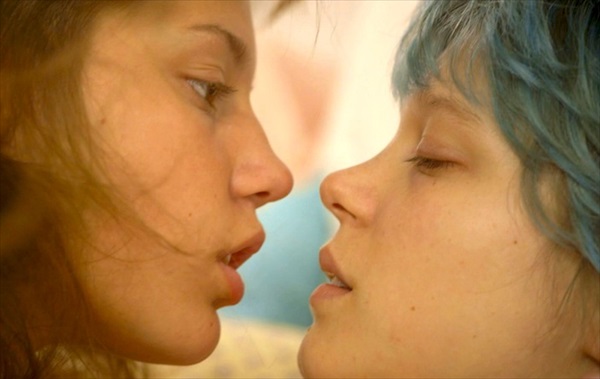In my entire life, I’ve only ever seen four films with lesbian relationships at their core in a mainstream cinema. Four. So to say I was intrigued to see this year’s Cannes Palme d’Or winner Blue Is The Warmest Colour would be an understatement. A French coming-of-age love story between two women, the film has made headlines for its subject matter, its seven-minute sex scene and its harsh director. But I went into Blue Is The Warmest Colour with an open mind and an empty bladder – I made sure of this, what with it being three hours long…
The story goes thusly: Adele is 17 and in her final year at school. She has a boyfriend but is struggling with her sexuality, confiding to a gay friend that she feels like “she’s faking it.” She goes with him to a gay bar and meets blue-haired Emma who’s in her final year of a Fine Arts degree. They develop a friendship, have intense conversations about philosopy and art (as only French films do) and eventually end up together and in bed, having frantic, volcanic sex in the film’s much-discussed extended sex scene.
I was dreading the sex scenes: after all, what does a straight director know about lesbian sex? But my fears were unfounded. Sure, the sex might not be entirely accurate, but it is raw, intense and alive and thus goes some way to depicting the overwhelming nature of a defining first love. Plus, it’s not at all what you take away from the film – that honour goes to heartache.
Despite what the reviews and the snide comments would have you believe, the film is not about sex which takes up around ten minutes of a 180-minute film. The film is about coming-of-age and realisation, it’s about a character-defining intense relationship that stutters to life, is all-consuming and then, gradually, falls apart, leaving its two key protagonists changed forever. It’s about that love in your life that you never quite get over.
Is it too long at three hours? Yes of course it is. It takes almost an hour for Adele to meet Emma but their relationship and their intoxicating passion is beautifully depicted by both actresses (Lea Seydoux and Adele Exarchopoulos). The film is also packed with drawn-out close-ups and if you’re uncomfortable watching people eat, take a strong stomach as there are a whole lot of oysters and spaghetti involved.
In the end though, director Abdellatif Kechiche has managed to create a truly special piece of cinema, even if it is at times indulgent and overlong. Sadly, both Seydoux and Exarchopoulos complained about mistreatment on set and have stated they will never work with Kechiche again. Given that, it’s even more remarkable they were able to make the moving film they have.
